Physical Address
304 North Cardinal St.
Dorchester Center, MA 02124
Physical Address
304 North Cardinal St.
Dorchester Center, MA 02124
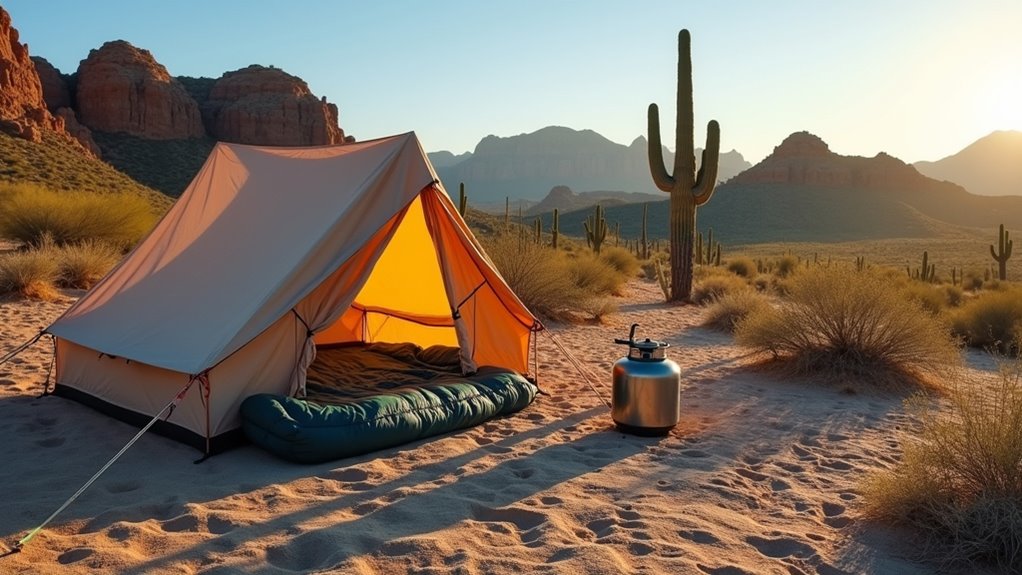
Gear up for desert camping success with these 9 crucial tips that could save your life in nature's harshest terrain.
Like Lawrence of Arabia crossing endless dunes, you’ll face challenges that can make or break your desert camping adventure. The unforgiving landscape doesn’t forgive poor planning—scorching days give way to freezing nights, water becomes precious currency, and one wrong turn can leave you dangerously lost. But here’s the thing: with the right knowledge, you’ll transform potential disaster into an unforgettable experience. These nine essential tips will mean the difference between surviving and thriving in nature’s most demanding classroom.
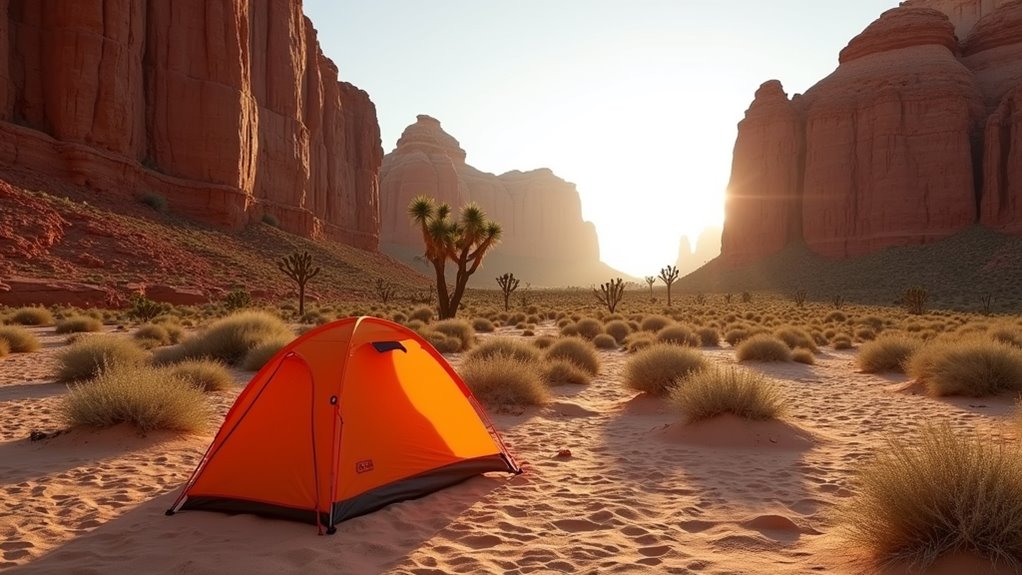
When scouting for your desert campsite, you’ll want to prioritize safety and comfort over scenic views. Avoid camping in washes or low-lying areas where flash floods can occur without warning.
Look for elevated, flat ground that’s protected from prevailing winds but still allows airflow for cooling.
Stay away from cliff bases where rockfall is possible, and don’t camp directly under large cacti or dead trees.
Choose spots with natural windbreaks like rock formations or sturdy vegetation, but maintain distance from wildlife corridors near water sources.
Check for ant hills, snake holes, and sharp rocks before setting up.
Face your tent opening away from the wind direction, and ensure you’re on public land or have proper permits for designated camping areas.
Consider exploring with caravan camping setups that offer enhanced mobility to reach remote desert locations while providing additional shelter and storage options.
After securing the perfect campsite, your next priority becomes managing your most precious desert resource: water. Pack at least one gallon per person per day, then add 50% more as your safety buffer. Desert heat increases dehydration rates dramatically, even during cooler months.
Store water in multiple containers to prevent total loss if one breaks. Keep bottles shaded and insulated to maintain cooler temperatures. You’ll drink more when water isn’t scorching hot.
Plan conservation strategies before you’re thirsty. Use minimal water for cooking by choosing one-pot meals. Clean dishes with sand first, then use small amounts of water for final rinsing. Collect morning dew on tarps if possible.
Monitor your urine color—pale yellow indicates proper hydration, while dark yellow signals immediate water intake needs. Remember that family camping creates shared responsibility for water management, making it easier to track everyone’s hydration levels and spot potential problems early.
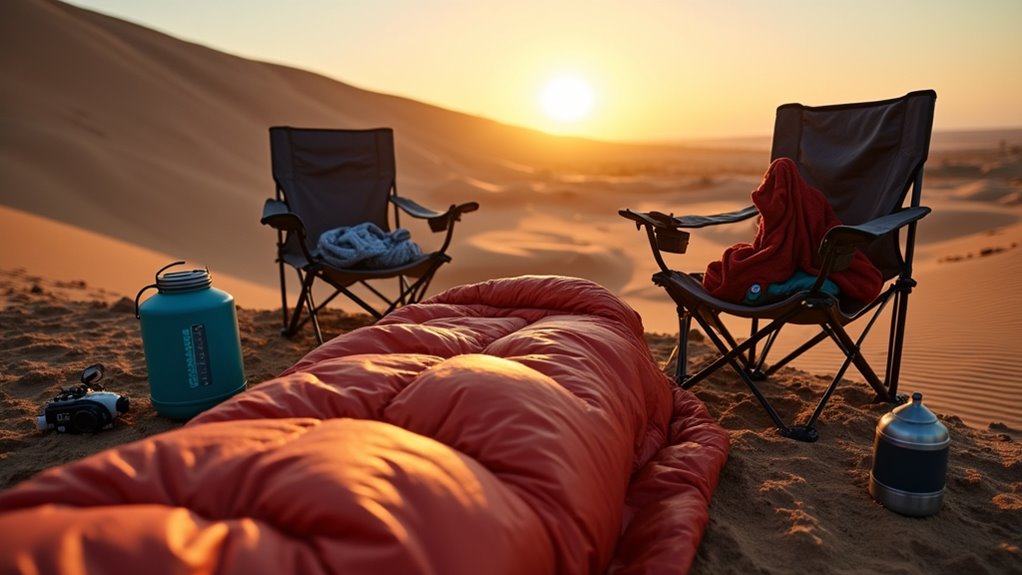
Desert temperatures swing wildly between scorching days and surprisingly frigid nights, often dropping 40-50 degrees Fahrenheit within hours of sunset. You’ll need gear that handles both extremes effectively.
Pack a quality sleeping bag rated for nighttime lows, even if daytime temps hit triple digits. Layered clothing works best—lightweight, breathable fabrics for day wear and insulating layers for evening. Don’t forget a warm hat and gloves for those chilly desert nights.
Set up camp with temperature swings in mind. Position your tent to catch morning sun but avoid afternoon heat exposure. Bring extra blankets as backup warmth. Store temperature-sensitive items like batteries and electronics in insulated containers, as extreme heat and cold drain power quickly and damage equipment.
Since standard camping equipment won’t cut it in harsh desert conditions, you’ll need specialized gear designed to handle sand, extreme heat, and minimal shade.
Your tent should feature reflective materials and excellent ventilation to combat scorching daytime temperatures. Look for models with reinforced floors that resist punctures from sharp rocks and thorns.
Essential desert-specific items include:
Don’t forget a quality headlamp with extra batteries, as desert nights arrive quickly and can be surprisingly dark without city lights nearby.
For desert environments where trees are scarce, consider that a jungle hammock setup can still work effectively when anchored to sturdy desert plants or portable hammock stands.
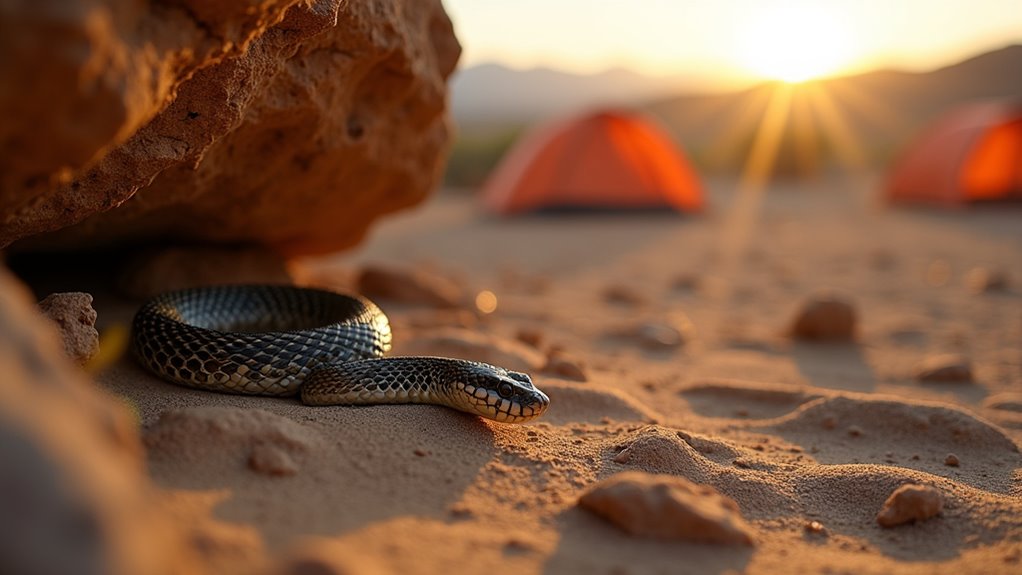
While desert landscapes may appear barren and lifeless, they’re actually home to a diverse array of wildlife that’s perfectly adapted to survive in these harsh conditions—and you’ll need to respect their territory.
Venomous snakes like rattlesnakes are most active during dawn and dusk, so use a flashlight when moving around camp. Store food in sealed containers to avoid attracting coyotes, javelinas, and desert rodents.
Desert wildlife follows predictable patterns—rattlesnakes hunt at twilight, while food scents draw hungry coyotes and javelinas to campsites.
Check your shoes and sleeping bag before use—scorpions love dark, confined spaces. Never approach or feed wild animals, even seemingly harmless ones like desert bighorn sheep.
Keep your campsite clean and pack out all trash.
If you encounter a large predator like a mountain lion, make yourself appear large, maintain eye contact, and back away slowly while making noise.
Even in desert environments, perform regular tick checks on your body and clothing, as these parasites can be found in areas with vegetation or where wildlife congregates.
Beyond keeping yourself safe from desert wildlife, you’ll need reliable methods to find your way across terrain where landmarks can look identical and GPS signals may fail. Desert navigation demands multiple backup systems since technology isn’t always dependable in remote areas.
Start with a quality compass and topographic map, learning to triangulate your position using distant mountains or rock formations. Practice reading contour lines before your trip. Always inform someone of your planned route and expected return time.
Essential navigation tools include:
These redundant systems ensure you’ll find your way safely through featureless desert expanses. When building your navigation kit, search for discount camping gear online to find quality equipment at better prices.

Although desert navigation keeps you on track, timing your arrival and departure can make or break your entire camping experience. You’ll want to arrive at least two hours before sunset to set up camp in daylight.
Desert temperatures drop rapidly after dark, making tent assembly and gear organization challenging.
Plan your departure for early morning, ideally within an hour of sunrise. This timing lets you pack efficiently while it’s still cool and hit the trail before scorching midday heat.
Monitor weather forecasts closely – sudden storms can create flash flood conditions or make roads impassable.
Always inform someone of your exact arrival and departure schedule. Cell service is often nonexistent, so having a reliable timeline helps rescuers locate you if problems arise during your desert adventure.
If you’re interested in more challenging outdoor adventures, consider exploring glacier climbing trails which offer completely different timing and preparation requirements than desert camping.
Once you’ve established your camp timing, desert sun and sand become your primary physical challenges throughout your stay. You’ll need all-encompassing protection strategies that go beyond basic sunscreen application.
Your protective gear arsenal should include:
Apply broad-spectrum SPF 30+ sunscreen every two hours, focusing on often-missed spots like ears, feet, and behind your knees.
Keep extra clothing sealed in bags to prevent sand infiltration that causes skin irritation.
Many experienced desert campers find that their time in challenging outdoor environments creates lasting meaningful experiences that strengthen their connection to nature and personal resilience.
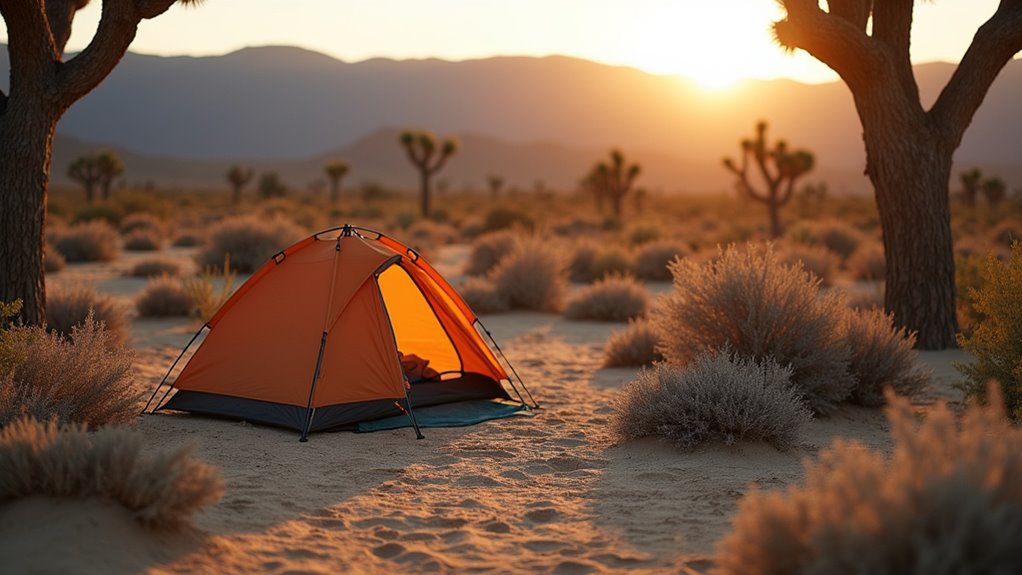
While desert landscapes appear barren and resilient, they’re actually fragile ecosystems that can take decades to recover from human impact. You’ll need to camp on durable surfaces like rock, gravel, or previously disturbed areas rather than fragile desert soil or cryptobiotic crusts.
Pack out all trash, including food scraps that won’t decompose in arid conditions. Use established fire rings if fires are permitted, or better yet, bring a camp stove since wood is scarce. Don’t move rocks or build cairns—they provide shelter for desert wildlife.
Keep noise levels down to avoid disturbing animals. Most importantly, stick to designated trails and campsites when available, as your footprints can last for years in desert environments. Planning ahead and preparing properly will ensure you have the knowledge and equipment needed to minimize your impact while enjoying the great outdoors.
You’re the desert’s temporary guest, not its conqueror. Like a respectful visitor in someone’s ancient home, you’ll leave only footprints and take only memories. The desert’s taught you its harsh lessons about preparation, respect, and humility. You’ve learned to dance with its extremes rather than fight them. Pack up your camp as if you’d never been there—the desert’s timeless story continues long after your brief chapter ends.